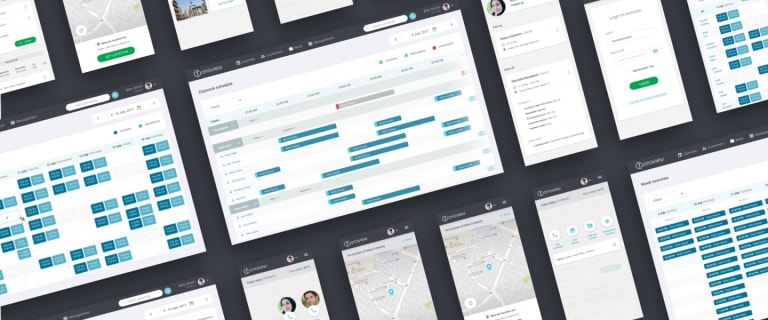How to announce new product features to drive adoption and engagement? Part 1
Your UX researcher uncovered a user pain point through a series of research methods, the product designer ran a number of iterations to ideate on several solutions and finally pick the most optimal one, the product team has been working diligently for the last sprint to deliver the functionality, hoping that it will mitigate the users’ pain straight away and make them love your product even more. The launch day comes and… It’s done, right? Well, not really. To make sure our users actually notice the updates, figure out how to use the new functionality quickly, and start deriving value from it, we should also take care of feature announcements.

Table of contents
Feature announcement is a set of measures you can take to inform both new and existing users about changes in your product. It’s helpful for big changes, such as redesign, but can also be valuable for smaller interface enhancements, such as a new filtering option, new action button, additional customization option, etc. which otherwise might be overlooked by the user.
This is a two-part article looking at how product features can be announced effectively. Part one focuses on why feature announcement is so important and lists the key channels you can use to reach out to users…
Why is it important to announce new features?
Smart communication helps to maintain good relationships with users and it’s an important part of the overall user experience. Here are some benefits of a carefully-conducted announcement campaign dedicated to users.
1. Overcome change aversion
Change aversion is a short-term negative reaction from users in response to changes in a product. It’s quite natural for humans to resist changes. For regular actions and processes our brain develops habits. Such mental shortcuts allow us to go through routine actions without much thinking, saving time and effort. Therefore, whenever there’s a change in a previously-known process, we’re likely to get distracted or annoyed because for us it means we can’t do it routinely without paying much attention but rather have to concentrate and learn the new way of doing things. And when it comes to digital products, in most cases people don’t want to learn how to use them, they want to use it and get their job done as quickly as possible.
That’s why changes in your product’s design, even the ones that have undergone thorough usability tests before the launch, can lead to a negative reaction among users which will eventually fade out as users get accustomed to the update.
It might be impossible to avoid change aversion altogether but there are some ways to mitigate it and announcing new features is one of them. By informing users beforehand about the upcoming changes and emphasizing their benefits we can spark their curiosity but also make the update less unpredictable and sudden for them. By using some in-app feature announcement tools, we can guide users to help them locate the new or updated functionality and find their way around it faster.
2. Improve your product’s reputation
Announcing new features or major updates and improvements can give a boost to your product’s PR and reputation. By regularly demonstrating that you’re constantly enhancing your product with your users in mind, you can emphasize your user-centered approach and show that you care about quality and user experience. The good reputation of your product can, in turn, help you acquire new customers and retain existing ones.
3. Increase feature discoverability and feature adoption rate
Discoverability describes whether users notice that certain features are present in the interface and how long it takes users to find out about them. The feature adoption rate demonstrates how many users start to use a new feature on a regular basis. Better discoverability and a higher feature adoption rate mean that users will be able to derive value from your product faster which leads to more profit for the business.
On the contrary, low feature discoverability is ultimately a waste of resources. Product teams may spend a few sprints delivering a functionality but if after the launch the users don’t even realize the feature is there, it inevitably slows down feature adoption and doesn’t bring much improvement to the user experience.
On the other hand, by announcing the feature through multiple channels, we can increase users’ awareness of the update. Additionally, by using some digital adoption tools, we can highlight the new feature directly in the interface to make it easier to locate, thus promoting its usage.
4. Helping customers reach the “Aha!” moment faster
The “Aha!” moment is the emotional reaction of a user when they suddenly discover the true value of the product and realize how it can benefit them. This is what causes them to stick with your product in the long run, converting them to loyal paying customers. This term is usually applicable for new users who are at the very beginning of their journey with your product and only starting to discover it. However, it’s also important to make sure that recurring customers have an “Aha!” moment every once in a while throughout their use of the product. It ensures higher user satisfaction, better retention rate and customer lifetime value.
New feature announcement is a powerful tool to get your customers closer to the “Aha!” moment. Educating your users about your product functionality and its potential benefits via various channels can help them realize your value proposition sooner.
5. Re-engaging with leads
Announcing your product updates and improvements through mailing campaigns or social media can be a perfect occasion to remind your potential customers about your product, showcase its newly-added advantages and encourage them to interact with the product again.
6. Reactivating churn users
Re-engaging with your churn users to inform them about your new features is a great opportunity to have another touchpoint with them. It may be even more efficient if the update you’re informing them about is personalized, based on a need they mentioned when churning. Pro tip: don’t forget to ask your churning customer for permission to send relevant product updates to them.
Most efficient channels for feature announcements
Choosing suitable communication channels can help with getting users’ attention at the right time and place. In my experience, the most efficient channels are:
1. Email campaigns
Lots of products use email campaigns to inform their users about recent updates. You can use such campaigns for major new features. Another approach is sending out monthly updates to sum up the value you’ve delivered during the month. When choosing an audience for mailing, keep your user personas and user segments in mind. Different segments of your target group might be interested in different use cases or nuances of your new feature. To highlight this accordingly, you may want to create a few mailing templates addressed to different customer segments to target their needs more precisely and make your mailings feel more personalized. Here are a few good practices to make your mailings more engaging:
- Choose a meaningful title. Generic titles, such as “Our product’s monthly update” or “Check out our new feature” will most likely not perform very well in terms of grabbing a user’s attention among the dozens of emails in their inbox. Try to concisely express the essence of your update in the title to entice the recipient to open your email.
- Make your emails actionable. Add a call-to-action button to your email template. It may lead to a blog post on your website to let users learn more or directly to your product to let users’ easily access and try out the new feature.
- Don’t forget about visuals. Depending on your brand guidelines you can add pictures, illustrations, or screenshots from your application showcasing the update. Consider sprinkling your update emails with some educational content, such as related articles from your blog, a video from your YouTube channel, etc.
2. In-app notifications
The benefit of in-app tools is that your user is already in the application and just a few clicks away from your new feature. Depending on the functionality of your application, you can use notifications, pop-ups, tooltips or other interface elements to highlight the new functionality. You may also consider having an in-app product updates center where users can check out the latest updates. Of course, developing such subpages or interface elements from scratch may require some time and effort. Instead you could consider using digital adoption platforms. Such tools offer a variety of ready-made elements such as hotspots, pop-ups, tooltips and more which you can use in your app with no development effort required. Some tools of this sort also offer a ready-made product updates hub which you can place in your app and fill with your own content.
3. In-app guides
In-app guides allow you to walk your users through a few steps, showing them the way to their goal, and providing helpful hints. Such guides are especially useful to showcase a more complex feature that requires a few sequential actions. They can also be extremely helpful to improve the user onboarding experience and increase user activation. Yet again, digital adoption platforms can come in handy in this case. In most tools of this kind you can also segment your users so that, for example, the guide is presented only to new users.
4. Website announcements
Ideally, your website or landing page should be delivering your unique value proposition (UVP). This can also include showcasing the value your users can get from using your product and its particular features. When developing a new functionality, consider what unique value it adds to your product and whether it’s worth mentioning on your website. Just remember to emphasize the value for your customer, not the technical solution.
5. Blog
A blog on your website is an ideal place to educate your users about your product and raise their awareness about its possibilities. You can also redirect the users to release notes or articles on your blog through other channels, such as email, social media or in-app notifications.
6. Social media
Social media can be a powerful tool to spread information about your product updates. Depending on your user persona and their social media activity, choose the platform(s) that will help you reach your target audience most efficiently. Social media can also be a great place to gather users’ reactions to your update, so you may want to check out what kind of comments and reactions you get under your update post.
7. Industry events
Take part in industry conferences and webinars, or organize them on your own. Share invitations to your event, walk your audience through your updates, and let them ask questions in real time. Not only does this increase your existing users’ awareness about new features and engagement, but also it can attract some potential new users and serve as a great source of customer feedback and marketing research.
As we can see, failure to plan for feature announcements risks leaving users behind. Whatever the size of change - from subtle improvements to complete overhauls - adoption depends on reaching out to users, both new and established, using a variety of means.
In part two, we will look at the practical reality of planning and designing an in-app feature announcement.
Share this article:









